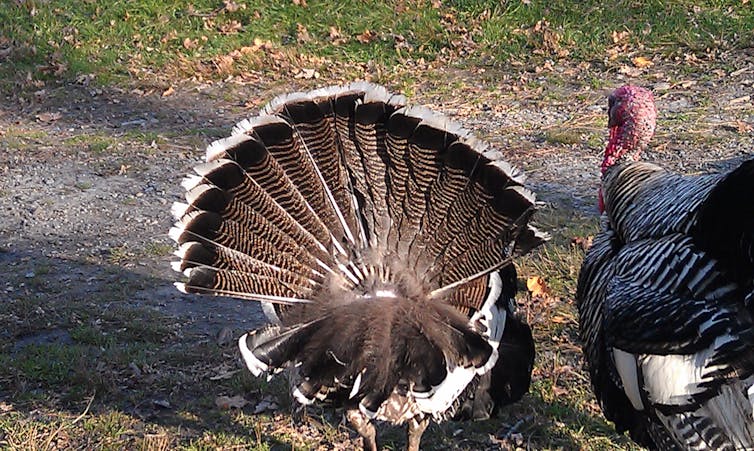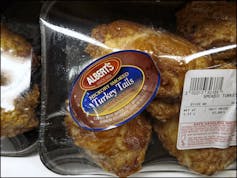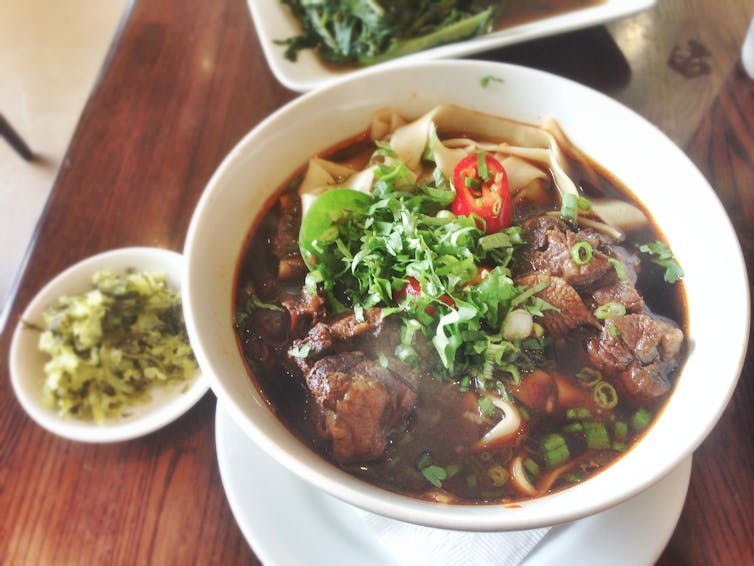Source for Pet Beef Tail Turkey, South America
Editor'due south note: Michael Carolan, sociology professor and acquaintance dean for enquiry in the College of Liberal Arts at Colorado State University, wrote this piece for The Chat in Nov 2017. Colorado State is a contributing institution to The Conversation, an contained collaboration between editors and academics that provides informed news analysis and commentary to the general public. Meet the entire list of contributing kinesthesia and their manufactures here.
Intensive livestock farming is a huge global industry that serves up millions of tons of beef, pork and poultry every year. When I asked 1 producer recently to name something his industry thinks about that consumers don't, he replied, "Beaks and butts." This was his shorthand for animate being parts that consumers – especially in wealthy nations – don't choose to consume.
On Thanksgiving, turkeys will adorn shut to 90 per centum of U.S. dinner tables. Only one part of the bird never makes information technology to the groaning lath, or even to the giblet bag: the tail. The fate of this fatty chunk of meat shows united states the baroque inner workings of our global food organization, where eating more of one food produces less-desirable cuts and parts. This then creates demand elsewhere – so successfully in some instances that the foreign function becomes, over time, a national delicacy.

Spare parts
Industrial-calibration livestock production evolved later Discussion War Ii, supported past scientific advances such every bit antibiotics, growth hormones and, in the case of the turkey, bogus insemination. (The bigger the tom, the harder information technology is for him to exercise what he'south supposed to do: procreate.)
U.Due south. commercial turkey production increased from 16 million pounds in Jan 1960 to 500 million pounds in January 2017. Total production this year is projected at 245 one thousand thousand birds.
That includes a quarter-billion turkey tails, also known as the parson'due south olfactory organ, pope's nose or sultan'due south nose. The tail is actually a gland that attaches the turkey'southward feathers to its body. It is filled with oil that the bird uses to preen itself, then near 75 percent of its calories come from fat.

Information technology's not clear why turkeys arrive at U.South. stores tailless. Manufacture insiders have suggested to me that it may but have been an economic decision. Turkey consumption was a novelty for most consumers before World War II, so few adult a gustatory modality for the tail, although the curious can find recipes online. Turkeys take go larger, averaging around xxx pounds today compared to 13 pounds in the 1930s. We've too been convenance for chest size, due to the American dear affair with white meat: One prized early large-breasted variety was call Bronze Mae West. Yet the tail remains.
Savored in Samoa
Rather than letting turkey tails go to waste, the poultry industry saw a business organization opportunity. The target: Pacific Island communities, where brute protein was scarce. In the 1950s U.S. poultry firms began dumping turkey tails, along with chicken backs, into markets in Samoa. (Non to exist outdone, New Zealand and Commonwealth of australia exported "mutton flaps," also known as sheep bellies, to the Pacific Islands.) With this strategy, the turkey manufacture turned waste matter into golden.
By 2007 the average Samoan was consuming more than 44 pounds of turkey tails every yr – a food that had been unknown at that place less than a century earlier. That'southward nearly triple Americans' annual per capita turkey consumption.
When I interviewed Samoans recently for my volume "No I Eats Alone: Food as a Social Enterprise," information technology was immediately clear that some considered this once-foreign nutrient function of their island'southward national cuisine. When I asked them to list pop "Samoan foods," multiple people mentioned turkey tails – frequently washed down with a common cold Budweiser.

How did imported turkey tails get a favorite amidst Samoa's working form? Hither lies a lesson for wellness educators: The tastes of iconic foods cannot be separated from the environments in which they are eaten. The more convivial the atmosphere, the more than probable people will be to have positive associations with the food.
Nutrient companies accept known this for generations. It's why Coca-Cola has been ubiquitous in baseball parks for more than a century, and why many McDonald's have PlayPlaces. Information technology besides explains our attachment to turkey and other classics at Thanksgiving. The holidays can be stressful, just they also are a lot of fun.
Every bit Julia, a 20-something Samoan, explained to me, "Y'all have to sympathize that nosotros eat turkey tails at domicile with family. Information technology's a social food, not something you'll eat when you're lone."
Turkey tails as well come up in discussions of the health epidemic gripping these islands. American Samoa has an obesity rate of 75 percent. Samoan officials grew so concerned that they banned turkey tail imports in 2007.
But asking Samoans to abandon this cherished food overlooked its deep social attachments. Moreover, under Earth Trade Organisation rules, countries and territories generally cannot unilaterally ban the import of commodities unless there are proven public health reasons for doing so. Samoa was forced to elevator its ban in 2013 equally a condition of joining the WTO, notwithstanding its health worries.
Embracing the whole animal
If Americans were more interested in eating turkey tails, some of our supply might stay at abode. Tin can we bring back and then called nose-to-tail animal consumption? This trend has gaining some footing in the The states, but mainly in a narrow foodie niche.
Beyond Americans' general squeamishness toward offal and tails, we have a cognition trouble. Who even knows how to carve a turkey anymore? Challenging diners to select, set up and eat whole animals is a pretty big ask.

Google's digitization of former cookbooks shows u.s. that it wasn't ever so. "The American Home Melt Book," published in 1864, instructs readers when choosing lamb to "observe the neck vein in the fore quarter, which should be of an azure-blue to denote quality and sweetness." Or when selecting venison, "laissez passer a knife along the basic of the haunches of the shoulders; if it odour [sic] sugariness, the meat is new and good; if tainted, the fleshy parts of the side volition look discolored, and the darker in proportion to its staleness." Clearly, our ancestors knew food very differently than we do today.
Information technology is not that we don't know how to guess quality anymore. Just the yardstick we use is calibrated – intentionally, as I've learned – against a unlike standard. The modern industrial food arrangement has trained consumers to prioritize quantity and convenience, and to judge freshness based on sell-by-date stickers. Nutrient that is processed and sold in convenient portions takes a lot of the thinking procedure out of eating.
![]() If this moving-picture show is bothersome, think nigh taking steps to recalibrate that yardstick. Perchance add a few heirloom ingredients to beloved holiday dishes and talk about what makes them special, perchance while showing the kids how to approximate a fruit or vegetable's ripeness. Or even roast some turkey tails.
If this moving-picture show is bothersome, think nigh taking steps to recalibrate that yardstick. Perchance add a few heirloom ingredients to beloved holiday dishes and talk about what makes them special, perchance while showing the kids how to approximate a fruit or vegetable's ripeness. Or even roast some turkey tails.
This commodity was originally published on The Conversation. Read the original article.
Source: https://source.colostate.edu/strange-story-turkey-tails-speaks-volumes-globalized-food-system/
0 Response to "Source for Pet Beef Tail Turkey, South America"
Post a Comment